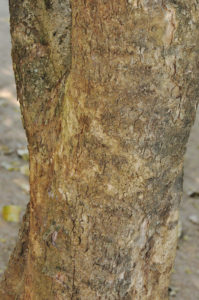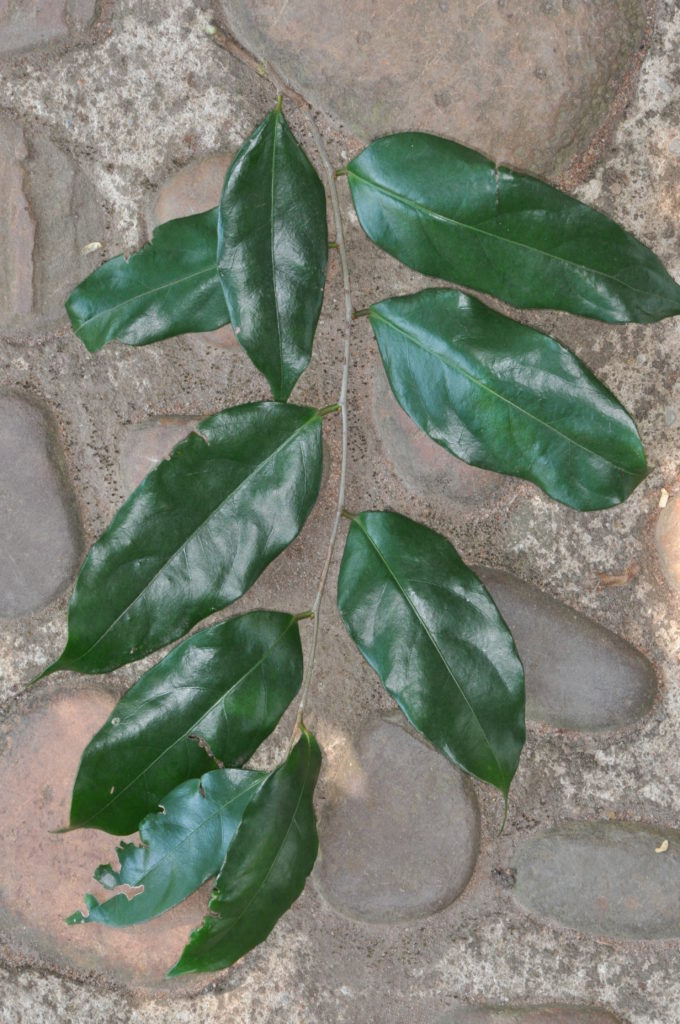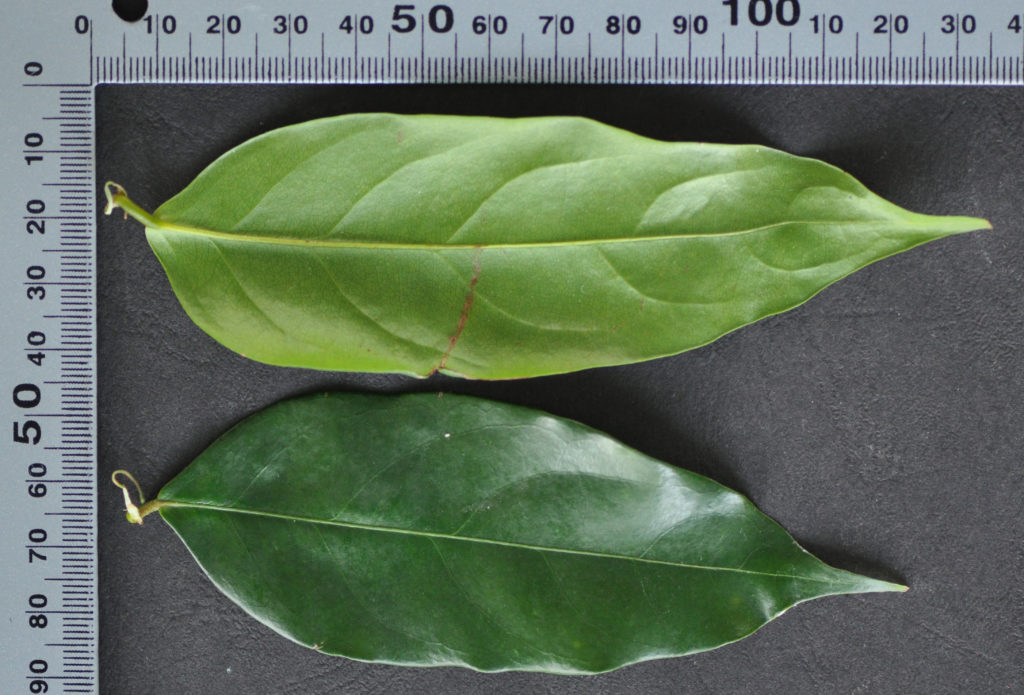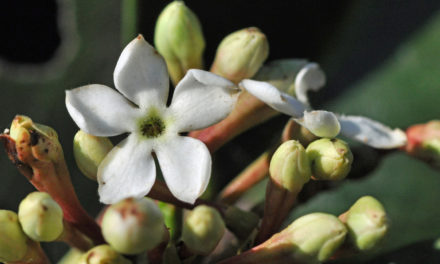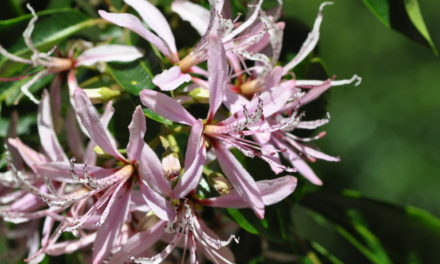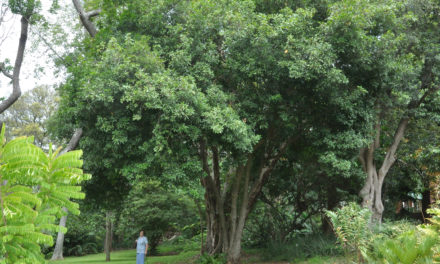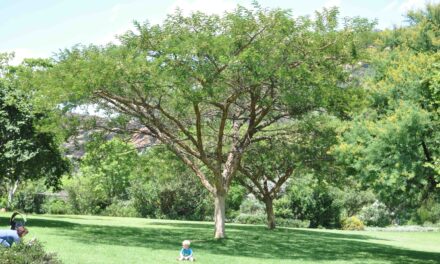General Info
This tree has a grey-brown bark and may reach 20m in height. The dark green, simple leaves are alternate. The small creamy white flowers are in racemes and are unisexual and monoecious. Fruit is a 3-lobed capsule.
Description
Tree
Common name: Forest Umzithi
Family: Phyllanthaceae. This family includes in excess of 50 genera and close to 2 000 species. Unlike most Euphorbiaceae latex is absent. The leaves that may be present have stipules – at least initially. They are entire. Flowers are actinomorphic. There are 2 ovules in each locule of the superior ovary. Genera include Antidesma, Bridelia, Heywoodia and Cleistanthus.
Name derivation: Cleistanthus – closed flower (Greek) refers to the flowers remaining partly closed. polystachyus – poly (many) and stachys (spike).
Conservation Status: Not indigenous in the RSA.
Tree is up to 20m high. Bark is grey-brown and usually rough and fissured into rectangles or it is vertically smooth. Terminal branches tend to droop. Branchlets are purplish grey or brown and have small lenticels (usually raised corky oval or elongated areas on the plant that allow the interchange of gases with the environment) present.
- Lowveld Botanical Gardens
Leaves
Leaves are simple, alternate, oblong to elliptic to ovate and up to 15 x 6cm. They are dark green and shiny above and lighter yellowish green below. Up to 10 pairs of lateral veins are present and net-veining is clearer below. Apex ends in a drip-tip after a gradually tapering. The Base is broadly tapering to rounded and may be slightly lobed. The Margin is wavy and the Petiole (leaf stalk) is up to 7mm long. Stipules (basal appendage of the petiole) are lanceolate and may persist.
- 861 2014.09.09 Lowveld NBG. Photo: David Becking.
- 863 2014.09.09 Lowveld NBG. Photo: David Becking.
Flowers
Flowers are sweetly scented and creamy white on slender stalks which are covered with golden brown hairs. They are actinomorphic (regular, symmetrical. Perianth – calyx and corolla can be divided into 3 or more identical sectors) and in short compact racemes (a simple elongated inflorescence with stalked flowers that open in succession towards the apex) which may contain up to 40 flowers. The flowers are unisexual and monoecious (having both male and female reproductive organs on the same plant). Male and female flowers are sweetly scented and up to 1cm wide. The flower head is called a capitulum (false flower: a dense inflorescence having a collection of usually sessile flowers). Male and female flowers have 5 valvate (meeting by the edge without overlapping) Sepals which open widely and there are 5-minute Petals. Here the Disk (a more or less fleshy or elevated development of the receptacle) is ring or cup-shaped. In Male flowers, there are 5 Stamens which are united in their lower half into a central column. A sterile Pistil (a unit of the Gynoecium, the female element of the flower, composed of the Ovary, Style and Stigma) is present. In the Female flowers, the disk is double with the inner part surrounding the superior Ovary. The ovary has 3 locules – each one containing 2 ovules. Bifid (2-lobed; divided by a deep cleft or notch) Styles are present. (Sep-Dec).
Fruit
Fruit is a usually 3-lobed, pale creamy brown, hairy, warty, globose and dehiscent capsule (a dry fruit resulting from the maturing of a compound ovary with more than 1 carpel) is up to 1,5cm in diameter. From this capsule, dark brown seeds are released. These Seeds have thick fleshy cotyledons (seed leaf; primary leaf or leaves in the embryo).
Distribution & Ecology
This tree occurs in riverine, evergreen and even swampy forests at low altitude. They occur naturally in Zimbabwe e.g. in the Chiteme Forest – close to northwest part of Kariba Dam, Botswana, and in Mozambique. They are also found in central Africa – including Angola and the Congo.
Ethnobotany
Insert Ethnobotany Description Here
References
Coates Palgrave, M. 2002. Keith Coates Palgrave Trees of Southern Africa, edn 3. Struik, Cape Town.
Lawrence, G. H. M, 1951. Taxonomy of Vascular Plants, The Macmillan Company, New York. Tenth Printing 1965.
http://www.mozambiqueflora.com/speciesdata/genus.php?genus_id=839
http://www.lind.org.zw/treesociety/2003/october.htm
http://www.ville-ge.ch/musinfo/bd/cjb/africa/details.php?langue=an&id=174143
http://eol.org/pages/1147828/overview
http://posa.sanbi.org/flora/browse.php?src=SP

